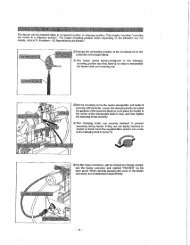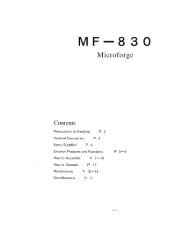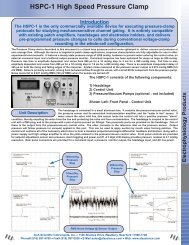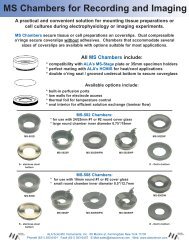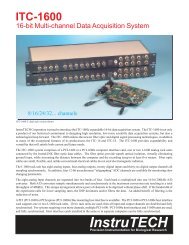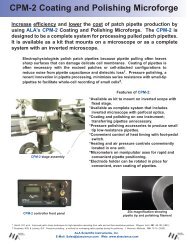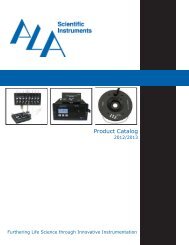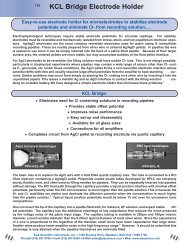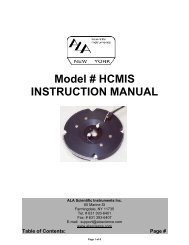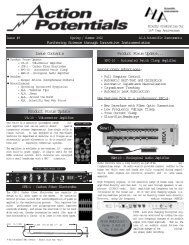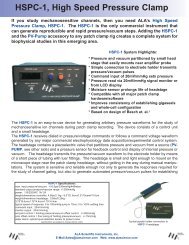4000 Series Brochure - ALA Scientific Instruments
4000 Series Brochure - ALA Scientific Instruments
4000 Series Brochure - ALA Scientific Instruments
Create successful ePaper yourself
Turn your PDF publications into a flip-book with our unique Google optimized e-Paper software.
STGTechnical DataSales InfoVoltage outputVoltage output resolutionVoltage ouput slopeCurrent outputCurrent output resolutionCurrent output slopeResolutionTime resolutionOutput signalsMaximum frequency (rectangular waveform)Interface (connection to computer)Download rateSoftware:Operating systemData importLabView interface available-8 V to +8 V @ +/-20 mA1 mV> 4 V/μs-1.6 mA to +1.6 mA @ 120 V100 nA100 μA/μs14 bit20 μsFreely programmable (rectangular, ramp, sinewave)25 kHzUSB 2.0 High Speed480 MbpsWindows Vista or XPASCII file formatDistributed by:Multi Channel SystemsMCS GmbHAspenhaustrasse 2172770 ReutlingenGermanyFon +49-7121-90 92 5- 0Fax +49-7121-90 92 5-11info@multichannelsystems.comwww.multichannelsystems.com© 2008Multi Channel Systems MCS GmbHProduct information is subject to change without notice.Products that are referred to in this document may be eithertrademarks and/or registered trademarks of the respectiveowners. The publisher and the author make no claim to thesetrademarks.•••••StimulusGenerators<strong>4000</strong> <strong>Series</strong>STGCompletely Software DrivenCurrent and Voltage Driven StimulationArbitrary Analog WaveformsIntegrated Isolation UnitsEach Channel - All Features - Full FlexibilitySTG
DescriptionFlexible WaveformsHigh-End FeaturesThree functions- One device:The stimulus generators of the <strong>4000</strong> series fulfill three functions in one device:• Current driven stimulation• Voltage driven stimulation• Controlling and timingWith the MC_Stimulus software you can choosebetween current or voltage driven stimulation.Freely programmable waveforms:Multi File Mode:backside of the STG4008 with 8 digital in- and outputsDecide in favour of 2, 4 or even 8 completely independentstimulus outputs.Every single output has the ability to provide anyarbitrary analog waveform as stimulation signal.For every single stimulus output there is one TTLin- and output, so you can synchronize your dataacquisition or trigger other devices.You can easily design your own waveforms with theWYSIWYG editor of the included stimulus software:freely combine mono- or biphasic rectangular pulses,ramps, or sine waveforms to design stimulationpatterns of unlimited complexity on each outputchannel.The STG<strong>4000</strong> series operates with a resolution of1 mV in voltage mode or 100 nA in current mode,and a time resolution of 20 μs. Single pulses can begrouped and looped to generate pulse trains withindividual timing and intervals. You can apply acompletely different protocol to each of the up to 8stimulation outputs. Repeat your stimulation protocolas many times as you need or let it run infinitelyand then stop it manually or on a trigger event. Aninternal quartz-controlled clock guarantees precisetiming over a long period.Extended Multi File Mode:In addition to switching between different stimulationprotocols on separate channels, the Multi Filemode makes it possible to switch between differentpatterns on the same electrode(s). You can load upto 8 different stimulation files, each containing theindividual program for up to 8 separate stimulatingelectrodes. Each stimulation file is controlled by aseparate trigger. This feature allows you to switchrapidly between up to 8 different stimulation protocolson the same or overlapping channels.For example, you can control stimulation pattern A(red arrows in the figure) by trigger 1 on electrode1, 2, 3, and stimulation pattern B (green arrows) bytrigger 2 on electrode 2 and 3, and so on. With thisfeature, you can react with different pulse patterns inresponse to the biological behavior.Current driven stimulation:In current mode, the stimulus generator guaranteesa stable current output in the range of-1.6 mA to +1.6 mA independent of the electrodeimpedance @ 120V compliance voltage.On request, a version with an extended outputrange of ± 16 mA is available.For a broad range of applications:Neuronal networks:• Long time stimulation• Feedback stimulation• White noise stimulation• Biological signals as stimulation patterns• Multiple files can be applied to one or moreelectrodesVoltage driven stimulation:In voltage mode, the voltage level in the range of-8 V to +8 V is held constant and the currentoutput depends on the electrode impedance. Thelower the electrode impedance - the higher theoutput current. The maximum output current is± 20 mA.Brainslices:• Flexible LTP induction patterns• Studies of synaptic plasticitySceletal Muscle:• Evoke isometric and isotonic contractionsCardiac cells and tissues:• Study influence of artificial pacemakers• Pace cardiac cell cultures• Pace tissue preparations like slices, purkinje fibers,or papillary muscle• Mimic cardiac environment during stem cell differentiationThe Stimulators can receive and deliver TTL pulsesvia BNC connectors for every single stimulationoutput. These triggers allow you to control andsynchronize other instruments like imaging systems,LED-lights, data acquisition systems and many more- at a 20µs precision.Importing external ASCII files:You can also import files generated by externalprograms, for example biological signals capturedby a data acquisition system or curves derived fromcomplex mathematical functions.Imported signals can be further edited, grouped, orrepeated directly in the included stimulus softwareMC_Stimulus and are simply downloaded onto thestimulus generator by a single mouse click. Theexample shows a spike waveform recorded from anorganotypic hippocampal culture on a microelectrodearray (MEA) at a sampling rate of 50 kHz afterthe ASCII import into the MC_Stimulus program.Triggering stimulation:Every stimulation pattern can be started andstopped manually or on an external trigger (TTL), forexample from a switch or any other external control.The STG<strong>4000</strong> series allows you to trigger each of theup to 8 analog output channels independently.Each stimulator is equiped with one TTL output andone TTL input for each stimulation channel. The stimulationon up to 8 channels can be controlled by thesame trigger (synchronous operation), or by differenttriggers (independent or asynchronous operation).This way, you can apply up to 8 complex stimulationpatterns to separate stimulating electrodes with aprecise timing based on different trigger sources orcriteria.The extended Multi File Mode is controlled throughthe Digital In (D-IN) of the Stimulus Generator. TheD-IN has an 8 bit resolution and can assume 256 differentstates. Correspondingly, up to 256 stimulationpatterns (files) can be downloaded to the StimulusGenerator, and each pattern can be assigned to onestate of the D-IN. Each of these stimulation patternscan define the output of one or more of the STGsstimulation and SyncOut channels.With the D-IN interface you can now automaticallyswitch between different stimulation patterns witha latency of only a few microceconds. There are twomodes available for the Extended Multi File function,continuous and triggered. In continuous mode,the STG continuously monitors the state of the D-INand starts the assigned stimulation pattern as soonas the state of the D-IN changes. In triggered mode,the same happens only when an additional externaltrigger is applied.Dynamic online changes and downstreaming:The stimulus generators of the <strong>4000</strong> series are theonly commercially available pulse generators thatcan dynamically change the output signal anddownstream pulses during stimulation. Thus, youcan stimulate continuously over several days, weeks,even months, and generate stimulation sequenceson the fly during the experiment.Imagine the possibilities of the system, like feedbackstudies or modulated white-noise stimulation. TheStimulus Streamer, a basic program for loading andplaying ASCII and MP3 files will be provided, but youcan integrate the program controls (DLL) into yourcustom program as well. For example, you can usebiological signals recorded with your custom dataacquisition system and feed the data directly into thestimulus generator, making it perfect for neuronalnetwork studies.



